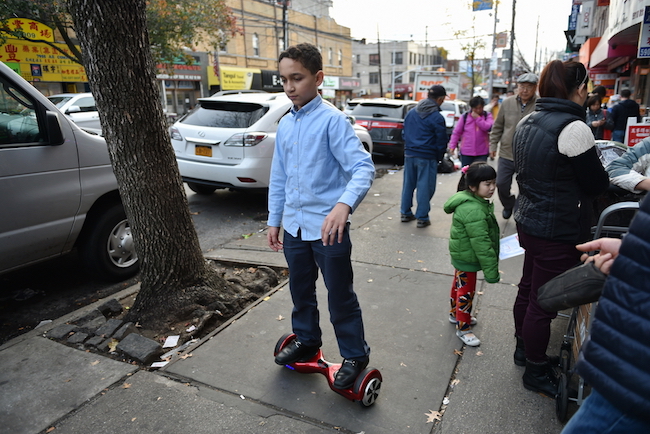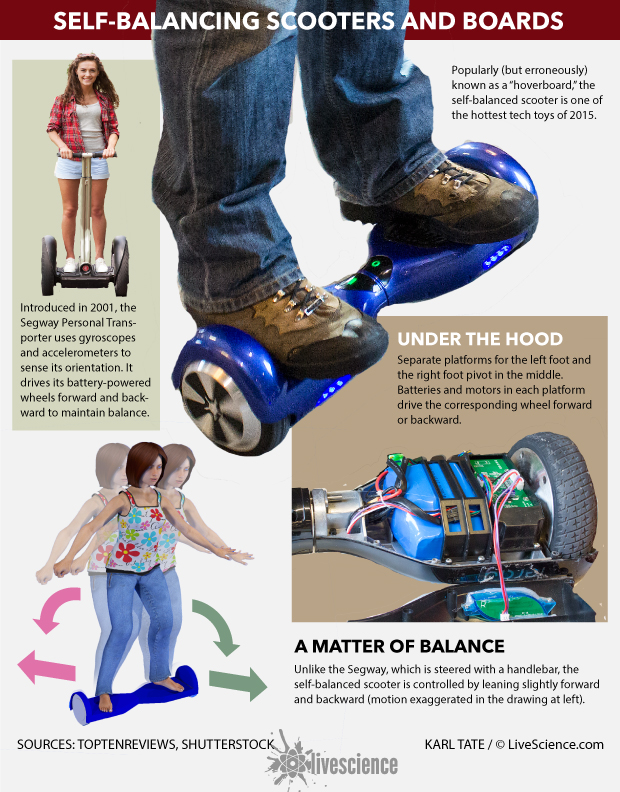
Why the 'Hoverboard' Scooter Is So Fly

This story was updated at 1:57 p.m. ET on March 25, 2016.
Editor's Note: An investigation by the United States Consumer Product Safety Commission concluded that no hoverboards currently for sale in the U.S. can be considered safe until they meet new safety standards and are certified by UL, an independent safety certification company. Consumers are advised to look for UL certification on any future hoverboard purchases. In addition, Amazon is offering refunds for hoverboards purchased through their site.
Some call them hoverboards; others call them smart or self-balancing scooters. But whatever you call the two-wheeled motorized vehicles you've probably seen rolling over sidewalks of late, one thing is certain: These futuristic gadgets are pretty cool. And the physics and mechanics that make them go are cool, too.
Unlike true hoverboards, which float above the ground using magnetic levitation technologies, smart scooters have two wheels that roll over the ground. These small vehicles lack handlebars, making them trickier to operate than Segways, which have a bar for riders to hold onto that extends from the footboard to arm height.
To stay balanced on a smart scooter, you must control the movement of the device using just your feet. To move forward, you lean forward, pushing down with your toes. To move backward, you lean backward, pushing down with your heels. Turning is a bit more complicated (but more on that later). [Gift Ideas for Kids: Best Educational Toys and Games of 2015]
But what actually makes a "hoverboard" go? It starts with the wheels, according to the folks at BestElectricHoverboard.com. Each of the board's wheels contains a motor, as well as sensors that detect the tilt of the board and its speed. These sensors, which are activated by your weight on the board, send the information they gather to a control board and a gyroscope (a device that helps the scooter orient itself and remain stable), located inside the foot platform.
Information about the tilt of the board and its speed is then passed along to the scooter's "brain," or main logic board. This small computer processes all of the information from the vehicle's control board and gyroscopes, and then sends data back to the motors, telling them how fast to turn the wheels and in which direction to turn them.
Sign up for the Live Science daily newsletter now
Get the world’s most fascinating discoveries delivered straight to your inbox.

To imagine how this process works, picture yourself trying to move forward while standing on one of these vehicles. When you press your toes down and lean forward, this movement is picked up by the sensors. Then, it's translated by the control board and gyroscopes and is sent to the logic board, which then tells the motors to move the wheels forward at a speed that will "keep up" with your forward-leaning body and keep you from falling flat on your face. To turn right, you would lean forward on your left foot and backward on your right foot. These movements would make the left wheel move forward and the right wheel move backward, turning the whole board toward the right.
Editor's Note: Amazon has suspended sales of many "hoverboard" scooter brands on its site, due to safety concerns following a series of hoverboard-related fires. The United States Consumer Product Safety Commission is in the midst of an investigation into the safety of the self-balancing scooters.
Follow Elizabeth Palermo @techEpalermo. Follow Live Science @livescience, Facebook & Google+. Original article on Live Science.

Elizabeth is a former Live Science associate editor and current director of audience development at the Chamber of Commerce. She graduated with a bachelor of arts degree from George Washington University. Elizabeth has traveled throughout the Americas, studying political systems and indigenous cultures and teaching English to students of all ages.










